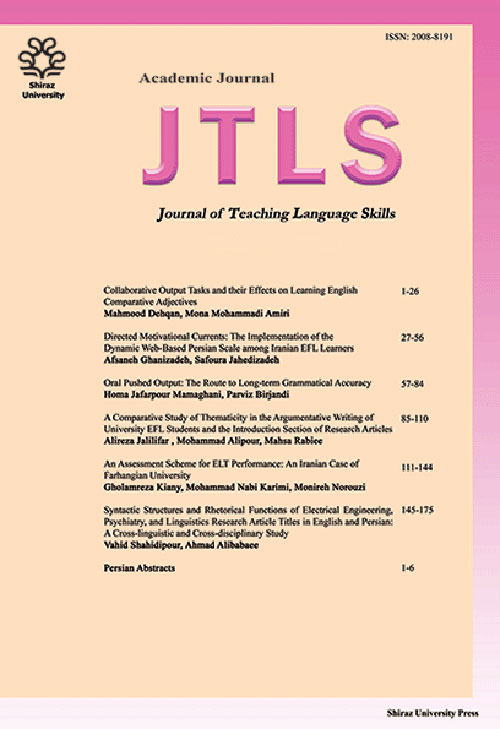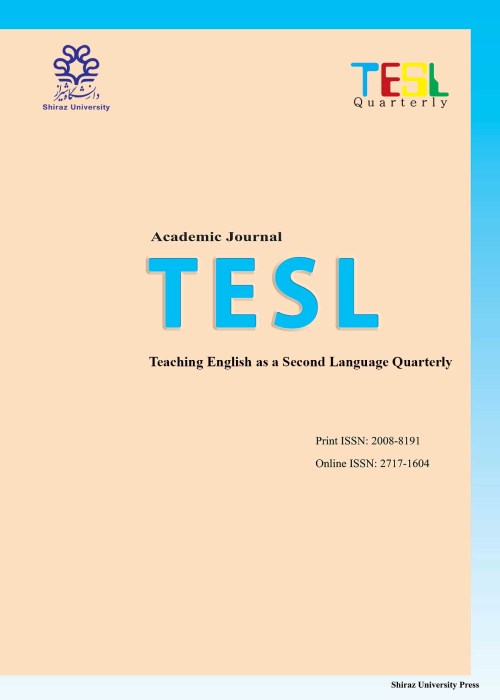فهرست مطالب

Teaching English as a Second Language Quarterly
Volume:10 Issue: 4, Winter 2019
- تاریخ انتشار: 1398/01/07
- تعداد عناوین: 6
-
-
Pages 1-46
The major objective of this experimental research was to assess the differences between two varieties of focus on form instruction, namely proactive and reactive across multimodal vs. traditional input settings in both comprehension and production of modal auxiliaries. The participants of the study were 75 Iranian English as a foreign language (EFL) high school students at the elementary level in three classes. The students in each class took part in a pre-test including both comprehension and production items. Then, they were randomly exposed to one of the three types of grammar instruction, i.e. proactive focus on form in which students were exposed to multimodal input through preplanned techniques of input enhancement and input flood, reactive focus on form in which the tasks occurred in multimodal episodes including negotiation and correction by the instructor through recasts, clarification requests, and repetition techniques. Lastly, in the control group, the students were provided with a pamphlet and their teacher’s explanations. The post-test was then administered to the three groups, and the results were analyzed by conducting a one-way-analysis of covariance (ANCOVA) which revealed a significant difference among these three groups. The results showed that the proactive group outperformed the reactive and control groups both in the comprehension and production of modal auxiliaries. At the end of the experiment, a brief survey which was accomplished through an interview revealed that the majority of the students highly favored PowerPoint presentations, teacher's explanations, and video clips respectively. </strong>
Keywords: Modal auxiliaries, Multimodal input, Proactive focus on form, Reactive focus on form -
Pages 47-70
Inspired by Vygotsky’s Sociocultural Theory (SCT), the current study intended to investigate the effect of summary training (i.e., oral and written) on intermediate EFL learners’ reading comprehension in different conditions (i.e., individual and collaborative). Data collection tools and procedures encompassed PET test, First Certificate in English (FCE) reading pre-test, and post-test. First, to ensure that the instruments, scoring, as well as summary training procedures were reliable, the researchers conducted a pilot test. During the main study, 120 Iranian EFL intermediate male and female learners aged from 16-18 were considered as the main participants. Learners were divided into 6 groups (i.e., three individual and three collaborative conditions). Furthermore, each condition included three groups with oral summary, written summary groups, and no summary group. A post-test followed the treatment that lasted for 6 sessions. A series of ANOVA with follow up pair-wise comparisons</strong>and a series of independent-samples t-tests indicated that: (1) summary training, especially the oral one, was more effective in enhancing the EFL learners’ reading comprehension, and (2) members of the collaborative groups outperformed the members of the individual groups regarding their reading comprehension development. The theoretical and practical implications are discussed concerning enhancing the EFL learners’ reading comprehension. </strong>
Keywords: Summary training, Reading comprehension, Collaborative learning, Individual learning, Sociocultural theory -
Pages 71-108
The combination of implicit meaning-focused input and explicit instruction has been suggested by recent research as very effective for learning L2 vocabulary; however, the time sequence for such juxtaposition has not been adequately examined through empirical studies. Therefore, this study sought to find the optimal time for combining explicit and implicit L2 vocabulary instruction using an explanatory mixed-method design. A convenience sample of 62 upper-intermediate EFL learners from three intact classes participated in this study. The Test of Academic Word List (Version A) that assesses Coxhead’s (2000) Academic Word List (AWL) was administered as a pertest. The reading book, Focus on Vocabulary 2, that has been developed based on the AWL was used for giving meaning-forced input. The target words were explicitly pre-taught in Class A (n=22), taught concurrent with encountering them in the reading text in Class B (n=20), and post-taught in Class C (n=22). Version B of the AWL Test was used as the posttest and after a 14-day retention interval (RI) as the delayed posttest. Then, 25% of the learners were orally interviewed about their attitudes toward the treatment they received. Quantitative data analysis using one-way ANCOVA revealed that explicit teaching during the reading was the optimal time and could help learners significantly do better on the immediate and delayed post-tests followed by pre-teaching. Qualitative analysis also verified the obtained quantitative results. The findings of this study imply that explicit vocabulary teaching during the reading should be practiced by EFL teachers/learners for fostering vocabulary development.</strong>
Keywords: Explicit teaching, Implicit teaching, Vocabulary development, Vocabulary retention, Meaning-focused experience -
Pages 109-139
In English as a Foreign Language (EFL) and bilingual language classrooms, code-switching is widespread among teacher-student and student-student interactions; however, there seem to be few or no studies tracking the perceptions and practices of EFL learners toward code-switching. Therefore, the aim of this study was to identify the perceptions and practices of high and low achievers toward teacher code-switching with focus on the possible limitations and benefits that it might have in language classrooms. For this purpose, the researchers used a qualitative design in the form of grounded theory. Accordingly, 11 high and 13 low achievers were interviewed individually and in focus groups. Further, the elicited responses were transcribed and codified using Straus and Corbin’s (1998) constant comparative method. In addition, for the purpose of validation, real observations of 10 university classes in different English courses were made. The findings revealed 4 major themes and 26 categories for high and low achievers. Consequently, the findings implicated that code-switching was an advantageous tool at the disposal of English teachers.</strong>
Keywords: Code-switching, Bilingual context, Classroom discourse, High, low achievers -
Pages 141-165
Communicative language use largely entails regular patterns consisting of pre-constructed phrases or sequences. These sequences have been examined by many researchers to find the situation-based formulas which may help L2 learners follow a possibly more target-like speaking system. This study, therefore, explored two categories of formulaic expressions including speech formulas and situation-bound utterances used by EFL learners. The randomly selective participants included 30 intermediate and 30 advanced learners, who performed a total number of 120 role-play tasks focused on the situations which required the use of thanking, requesting, offering, and apology speech acts. Audio-recorded data from role-plays were transcribed and analyzed based on existing lists of speech formulas. Results showed that the participants produced more than 102 types of formulaic sequences that could be called “a list of pragmatic routines for thanking, requesting, offering, and apologizing speech acts in the EFL context”. This list includes 44 and 58 speech formulas and situation-bound utterances, respectively. Results further indicated that advanced language learners used more diverse situation-bound utterances in terms of its internal and contextual complexity than their counterparts in the intermediate group due to expert judgments. Because these formulas can increase coherence in speaking, and enhance effective and natural communication, their instruction could be part of the language teaching curriculum. </strong>
Keywords: Formulaic Expressions_Language Formula_Pragmatic Routines_Teaching English as a Foreign Language -
Pages 167-194
This study compared the effects of teacher-provided written corrective feedback and manipulation of resource-directing dimensions of task cognitive-complexity along +/- Here and Now condition on the grammatical accuracy of Iranian EFL learners’ writing products. There were 45 participants in the study who were randomly assigned to three experimental groups. All the participants were first given a prompt for the pre-test of writing, and then each group received its own intervention (direct written corrective feedback, indirect written corrective feedback, and task manipulation) for four sessions during four weeks. Subsequently, all the groups took the pre-test prompt of writing for their post-test performance after which the data were collected for the statistical analyses and fed into SPSS. The findings of the study confirmed the significant effects of direct written corrective feedback on increasing the grammatical accuracy of learners’ writings. There were implications, then, based on the results, highlighting the role of meaningful context of task application in the classroom.</strong>
Keywords: Written corrective feedback, Task manipulation, Grammatical accuracy, Direct feedback, Indirect feedback


